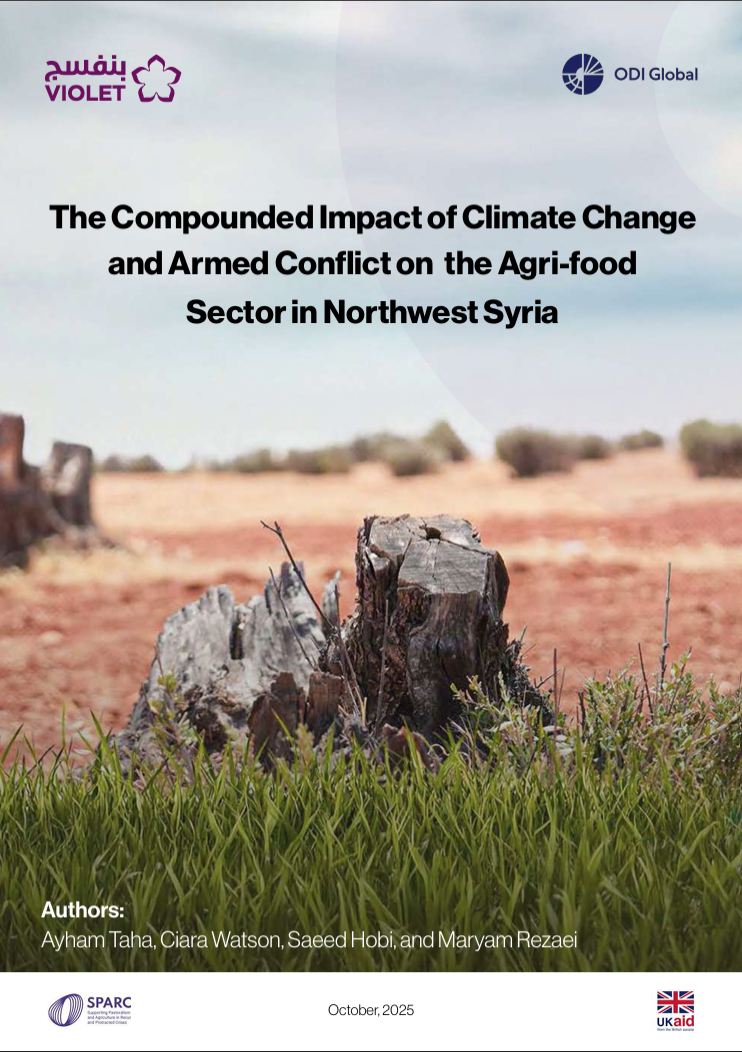The Compounded Impact of Climate Change and Armed Conflict on the Agri-food sector in NWS
Executive Summary
Agriculture has long been both an economic backbone and cultural anchor of rural livelihoods and a cornerstone of food security in Syria. The past decade of armed conflict, compounded by accelerating climate change, has resulted in the collapse of the agri-food system and devastated the lives of those who depend on it. This study addresses a critical evidence gap by documenting how climate change and conflict interact as threat multipliers, setting off causal chains that explain the failure of Syria’s major value chains, particularly wheat, olives, and livestock.

The value of this research is twofold. First, through extensive community engagement in Northwest Syria (NWS), it captures the lived experiences and priorities of farming and herding communities, voices that remain largely absent from existing humanitarian and development planning and funding models. Second, by tracing the evolution of Syria’s agri-food challenges before, during, and after the armed conflict, the analysis shows that many vulnerabilities that preceded the armed conflict, such as poor natural resource management, fragile governance, and inequitable policies, have been intensified by both violence and climate pressures over this period. Recognizing these historical patterns of failure and resilience is essential to chart credible recovery pathways. At this moment in Syria’s uncertain transition, generating evidence on how climate and conflict converge is indispensable for shaping meaningful interventions, ones that can rebuild a more inclusive, climate-resilient, and sustainable agri-food sector.
This participatory research shows how climate shocks including droughts, erratic rainfall, frosts, and pest outbreaks, directly undermine agricultural yields, livestock productivity, and the sustainability of natural resources. These stresses are then magnified by conflict factors: the destruction of irrigation and veterinary systems, restricted access to land, loss of skilled labour through displacement, and rising input costs driven by sanctions, border closures, and currency depreciation. Together, these compounded effects have devastated the sector. An estimated that 1.5 million olive trees were lost across Northwest Syria since 2011 (iMAAP, 2023); livestock herders report their herds are on average less than a third of their pre-conflict size; and the deficit in wheat production in 2025 was an estimated 2.73 million metric tons, enough to feed 16.25 million people (FAO, 2025). This has wide ranging consequences. Smaller herds and harvests reduce local supply; fractured markets limit distribution; and weakened purchasing power erodes household resilience, leaving communities more exposed to future shocks.
This crisis is also profoundly gendered. With the death, displacement, or migration of men, women shouldered a much greater share of agricultural and livestock work, managing land, herding, harvesting, and processing. However, this expanded role has not translated into empowerment as women remain excluded from markets, credit, and extension services, reinforcing wage gaps and structural inequality. For example, 72% of women in the olive sector report having assumed more responsibilities yet face a 20-50% wage gap with respect to their male counterparts and no representation in farmers’ associations. This dual reality of greater responsibilities but fewer opportunities is one of the most striking outcomes of the compounded crisis.
Across primary data collected, two insights consistently emerged across all three value chains:
- Communities identify climate as an urgent and long-term threat, while donors and non-governmental organisations (NGOs) often focus on immediate humanitarian needs, farmers and herders repeatedly emphasised that droughts, shifting rainfall, and heatwaves pose the gravest risks to their survival. They also showed a range of responses, from water management to crop diversification, often anticipating solutions more readily than external actors.
- Despite the compounded damage of armed conflict and climate shocks, pathways of resilience are emerging. Communities are not passive, and many are adapting practices, reorganising production, and relying on local networks. A striking example is the increased role of women in agricultural and livestock sectors. Although women face systemic exclusion from land, markets, credit, and decision-making, their assumption of greater responsibility in production and household survival positions them as critical agents of recovery. With targeted support in accessing finance, training, market access, and inclusion in governance structures, women can move from coping on the margins to leading resilience-building efforts
These findings inform a set recommendations that that are sequenced to match the realities of compounding risks:
- Short-term humanitarian priorities: ensuring access to feed, seed, water, and vaccination support, to stabilize livelihoods.
- Medium-term recovery: restoring veterinary and extension systems, strengthening cooperatives, and supporting women-led agribusiness to rebuild productive capacity.
- Long-term adaptation: investing in renewable energy, certified seed systems, drought preparedness, and climate-smart agriculture to address structural vulnerability.
This report does not offer a full action plan but provides a grounded starting point. Rooted in local realities and community voices, it highlights how conflict and climate interact and identifies practical entry points for recovery and resilience in Syria’s agri-food sector.
We thank the UK Foreign, Commonwealth & Development Office (FCDO), through the SPARC program, for their generous support, which made this work possible. The views expressed in this publication are those of the authors and do not necessarily reflect those of the FCDO.


